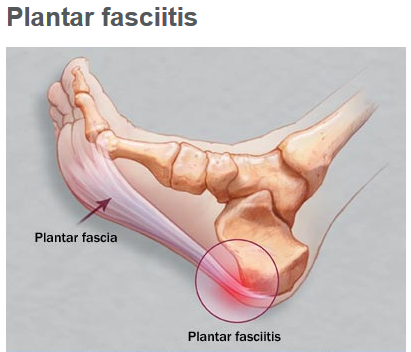by Dr. Jennifer Dahlseid, DC
 If you have ever dealt with some sort of heel pain there's a good chance that you were dealing with plantar fasciitis. It is the most common cause of heel pain and something we see most often when a patient comes to our office with pain at the bottom of their foot.
If you have ever dealt with some sort of heel pain there's a good chance that you were dealing with plantar fasciitis. It is the most common cause of heel pain and something we see most often when a patient comes to our office with pain at the bottom of their foot.
What exactly is plantar fasciitis?
Quite literally, plantar fasciitis is the inflammation (-itis) of the fascia on the bottom (plantar) side of your foot. Plantar Fasciitis is caused when the ligament that connects your toes to your heel (the plantar fascia) becomes inflamed, swollen, and weak. This causes the bottom of your foot or heel to hurt when you walk or stand, especially when you first wake or after sitting for a long time.
The pain usually begins as "tightness" or "soreness", then eventually tends to become sharp and stabbing pain. The pain tends to gradually decrease throughout the day, but may worsen with prolonged standing or athletic activity. Or an increase of pain may occur when you first get out of bed in the morning or after you've been sitting for while and then you first get up and put more pressure on your foot and heel . . . sometimes the pain can be very sharp.
It is the most common cause of heel pain and is more prevalent among middle aged people. However, anyone can get it at any age from a teenage athlete to the elderly, and especially people who spend a lot of time on their feet.
How is plantar fasciitis treated?
- Chiropractic Adjustments. Since the plantar fascia is most susceptible to tearing when your toes rapidly dorsiflex (extend upwards) during walking or running, it is important to strengthen the muscles that will limit the the speed of dorsiflexion in order to prevent re-injury. Good alignment of the foot, ankle and low back can be critical to having good strength and balance to prevent injury.
- Graston and/or Myofascial Release. The Graston Technique involves instrument-assisted soft tissue mobilization to treat soft tissue fibrosis (chronic muscle and tendon tightness) and chronic inflammation. The Graston Technique breaks up the scar tissue patches seen in plantar fasciitis and causes proper healing in those areas. Treatment increases the speed of healing and quickly reduces the sharp pain.
- Fascial Work. Your fascia is a thin layer of tissue surround your muscle and tendons. Over time adhesion's can form between the fascia and the muscle / tendon tissue increasing pain and spasm. Muscles and tendons may then remain chronically tight until these adhesion's between the fascia and muscle / tendons are worked on and released.
- Strengthen Foot Muscles. Since the plantar fascia is most susceptible to tearing when your toes rapidly dorsiflex (extend upwards) during walking or running, it is important to strengthen the muscles that will limit the speed of dorsiflexion in order to prevent re-injury.
- Elastic Sports Tape. While your foot is healing, the elastic tape provides comfortable support for the arch serving to relax the foot and reduce inflammation.
I think I have Plantar Fasciitis. What should I do now?
If you or someone you know has been dealing with foot or heel pain, whether you suspect it to be plantar fasciitis or not, schedule an appointment with our clinic to discuss your treatment options. Call today at (763)-241-5436.
